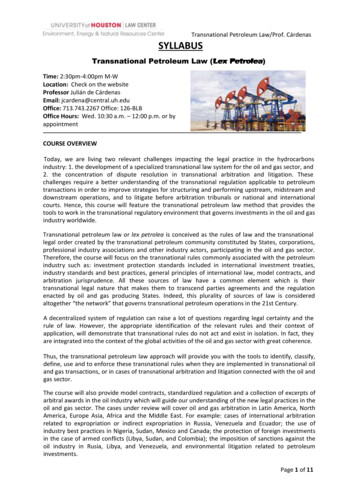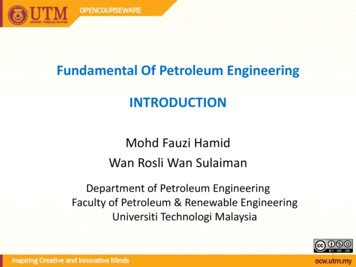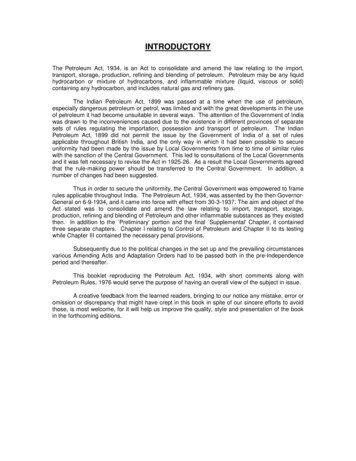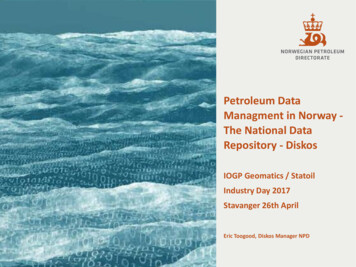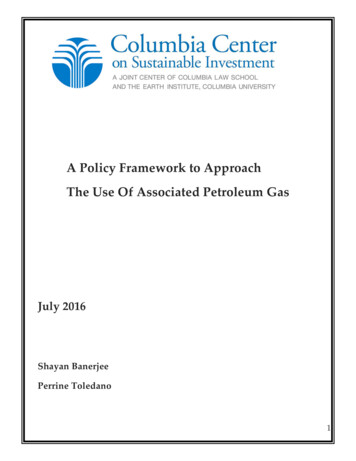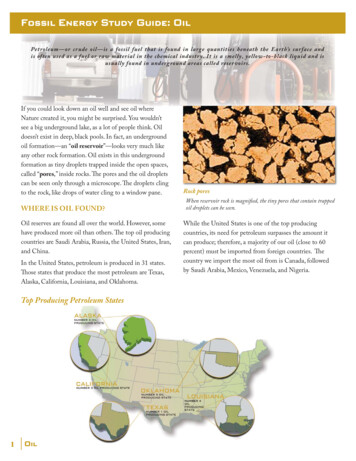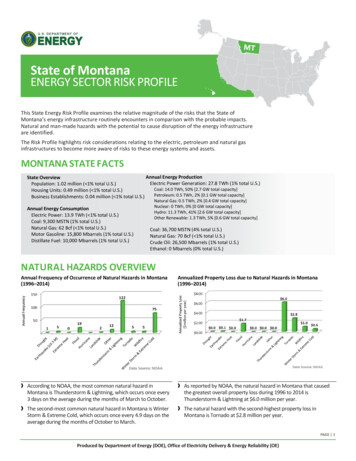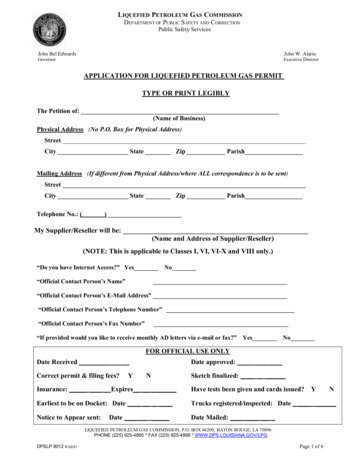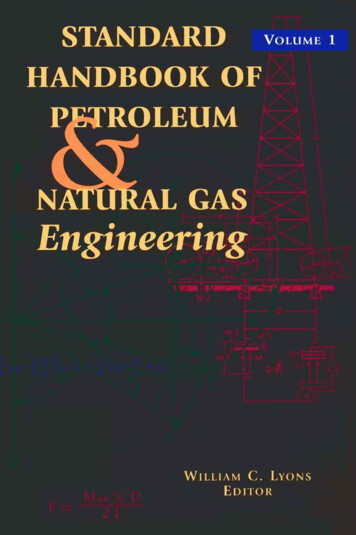
Transcription
STANDARDYSF-MEBX D21WILLIAMC. LYONSEDITOR
STANDARD HANDBOOKOFPETROLEUMAND NATURAL GASENGINEERINGVOLUME 1etroleum engineering now has its owntrue classic handbook that reflects theprofession’s status as a mature majorengineering discipline.PFormerly titled the Practical PerroleurnEngineer’s Handbook, by Joseph Zaba and W. ’1’.Doherty (editors), this new, completelyupdated two-volume set is expanded andrevised to give petroleum engineers a comprehensive source of industry standards andengineering practices. It is packed withthe key, practical information and data thatpetroleum engineers rely upon daily.The result of a fifteen-year effort, this handbook covers the gamut of oil and gasengineering topics to provide a reliablesource of engineering and reference information for analyzing and solving problems. Italso reflects the growing role of natural gas inindustrial development by integrating naturalgas topics throughout both volumes.More than a dozen leading industry expertsacademia and industry-contributed to thistwo-volume set to provide the best, mostcomprehensive source of petroleum engineering information available.
STANDARDHANDBOOK OFEngineering
STANDARDHANDBOOK OFWILLIAMC . LYONS, PH.D.,P.E.EDITORGulf Publishing CompanyHouston, Texas
STANDARDHANDBOOK OFROLEUML GASEngineeringCopyright 0 1996 by Gulf Publishing Company, Houston, Texas.All rights reserved. Printed in the United States of America. Thisbook, or parts thereof, may not be reproduced in any formwithout permission of the publisher.VolumeChapterChapterChapter2 Contents5 - Reservoir Engineering6 - Production Engineering7 - Petroleum EconomicsGulf Publishing CompanyBook DivisionP.O. Box 2608OHouston, Texas 77252-260810 9 8 7 6 5 4 3 2Library of Congress Cataloging-in-Publication DataStandard handbook of petroleum and natural gas engineering /[edited by William Lyons].p. cm.Includes bibliographical references and index.ISBN 0-88415-642-7 (Vol. l),ISBN 0-88415-643-5 (Vol. 2)1. Petroleum engineering.(William C.)TN870.S6233 1996665.5-dc202. Natural gas. I. Lyons, William96-13965CIPPrinted on Acid-Free Paper (-)iu
Contributing Authors.1-Mathematics .Prefaceviiix1Geometry, 3Algebra, 18Trigonometry, 27Differential and Integral Calculus, 35Analytic Geometry, 50Numerical Methods, 60Applied Statistics, 92Computer Applications, 108References, 1332-GeneralEngineering and Science.135Basic Mechanics (Statics and Dynamics), 137Fluid Mechanics, 168Strength of Materials, 185Thermodynamics, 209Geological Engineering, 240Electricity, 278Chemistry, 297Engineering Design, 365References, 386V
3-AuxiliaryEquipment. 391,Prime Movers, 393Power Transmission, 420Pumps, 458Compressors, 476References, 4954-Drillingand Well Completions.497Derricks and Portable Masts, 499Hoisting Systems, 523Rotary Equipment, 616Mud Pumps, 627Drilling Muds and Completion Systems, 650Drill String: Composition and Design, 715Drilling Bits and Downhole Tools, 769Drilling Mud Hydraulics, 829Air and Gas Drilling, 840Downhole Motors, 862MWD and LWD, 901Directional Drilling, 1079Selection of Drilling Practices, 1090Well Pressure Control, 1100Fishing Operations and Equipment, 11 13Casing and Casing String Design, 1127Well Cementing, 1 177Tubing and Tubing String Design, 1233Corrosion and Scaling, 1257Environmental Considerations, 1343Offshore Operations, 1363References, 1373. 1385,.1399Appendix: Units and Conversions (SI)Index. .vi
Contributing AuthorsFrederick E. Beck, Ph.D.ARC0 AlaskaAnchorage, AlaskaDaniel E. BooneConsultant in Petroleum EngineeringHouston, TexasGordon R. Bopp, Ph.D.Environmental Technology and Educational Services CompanyRichland, WashingtonRonald M. Brimhall, Ph.D., P.E.Texas A 8c M UniversityCollege Station, TexasRobert Desbrandes, Ph.D.Louisiana State UniversityBaton Rouge, LouisianaPatricia D. DuettraConsultant in Applied Mathematics and Computer AnalysisAlbuquerque, New MexicoB. J. Gallaher, P.E.Consultant in Soils and Geological EngineeringLas Cruces, New MexicoPhillip W. Johnson, Ph.D., P.E.University of AlabamaTuscaloosa, Alabamavii
Murty Kuntamukkla, Ph.D.Westinghouse Savannah River CompanyAiken, South CarolinaWilliam C. Lyons, Ph.D., P.E.New Mexico Institute of Mining and TechnologySocorro, New MexicoStefan Miska, Ph.D.University of TulsaTulsa, OklahomaAbdul MujeebHenkels 8c McCoy, IncorporatedBlue Bell, PennsylvaniaCharles Nathan, Ph.D., P.E.Consultant in Corrosion EngineeringHouston, TexasChris S. Russell, P.E.Consultant in Environmental EngineeringGrand Junction, ColoradoArdeshir K. Shahraki, Ph.D.Dwight's Energy Data, Inc.Richardson, TexasAndrzej K. Wojtanowicz, Ph.D., P.E.Louisiana State UniversityBaton Rouge, Louisiana.vtaa
This petroleum and natural gas engineering two-volume handbookis written in the spirit of the classic handbooks of other engineeringdisciplines. The two volumes reflect the importance of the industryits engineers serve (i.e., Standard and Poor’s shows that the fuels sectoris the largest single entity in the gross domestic product) and theprofession’s status as a mature engineering discipline.The project to write these volumes began with an attempt torevise the old Practical Petroleum Engineer’s Handbook that GulfPublishing had published since the 1940’s. Once the project wasinitiated, it became clear that any revision of the old handbookwould be inadequate. Thus, the decision was made to write anentirely new handbook and to write this handbook in the classicstyle of the handbooks of the other major engineering disciplines.This meant giving the handbook initial chapters on mathematicsand computer applications, the sciences, general engineering, andauxiliary equipment. These initial chapters set the tone of thehandbook by using engineering language and notation commonto all engineering disciplines. This common language and notationis used throughout the handbook (language and notation in nearlyall cases is consistent with Society of Petroleum Engineers publicationpractices). The authors, of which there are 27, have tried (and wehope succeeded) in avoiding the jargon that had crept into petroleumengineering literature over the past few decades. Our objective wasto create a handbook for the petroleum engineering discipline thatcould be read and understood by any up-to-date engineer.The specific petroleum engineering discipline chapters coverdrilling and well completions, reservoir engineering, production, andeconomics and valuation. These chapters contain information, data,and example calculations related to practical situations that petroleumengineers often encounter. Also, these chapters reflect the growingrole of natural gas in industrial operations by integrating naturalgas topics and related subjects throughout both volumes.This has been a very long and often frustrating project. Throughout the entire project the authors have been steadfastly cooperativeand supportive of their editor. In the preparation of the handbookthe authors have used published information from both the American
Petroleum Institute and the Society of Petroleum Engineers. Theauthors thank these two institutions for their cooperation in thepreparation of the final manuscript. The authors would also liketo thank the many petroleum production and service companiesthat have assisted in this project.In the detailed preparation of this work, the authors would liketo thank Jerry Hayes, Danette DeCristofaro, and the staff ofExecuStaff Composition Services for their very competent preparation of the final pages. In addition, the authors would like to thankBill Lowe of Gulf Publishing Company for his vision and perseveranceregarding this project; all those many individuals that assisted inthe typing and other duties that are so necessary for the preparation of original manuscripts; and all the families of the authors thathad to put up with weekends and weeknights of writing. Theeditor would especially like to thank the group of individuals thatassisted through the years in the overall organization and preparationof the original written manuscripts and the accompanying graphics,namely; Ann Gardner, Britta Larrson, Linda Sperling, Ann Irby,Anne Cate, Rita Case, and Georgia Eaton.All the authors and their editor know that this work is notperfect. But we also know that this handbook had to be written.Our greatest hope is that we have given those that will follow us, infuture editions of this handbook, sound basic material to work with.William C. Lyons, Ph.D., P.E.Socorro, New MexicoX
STANDARDHANDBOOK OFEngineering
Patricia DuettraConsultantApplied Mathematics and Computer AnalysisAlbuquerque, New MexicoGeometry.,.3Sets and Functions 3. Angles 3. Polygons 3. Triangles 3. Quadrilaterals 4. Circles and Spheres 4.Arcs of Circles 4. Concurrency 5. Similarity 5. Prisms and Pyramids 5. Coordinate Systems 6.Graphs 6. Vectors 6. Lengths and Areas of Plane Figures 7. Surfaces and Volumes of Solids 12.Algebra.18Operator Precedence and Notation 18. Rules of Addition 19. Fractions 20. Exponents 21.Logarithms 21. Binomial Theorem 22. Progressions 23. Summation of Series by DifferenceFormulas 23. Sums of the first n Natural Numbers 24. Solution of Equations in One Unknown 24.Solutions of Systems of Simultaneous Equations 25. Determinants 26.Trigonometry.27Directed Angles 27. Basic Trigonometric Functions 28. Radian Measure 28. TrigonometricProperties 29. Hyperbolic Functions 33. Polar Coordinate System 34.35.50Differential and Integral CalculusDerivatives 35. Maxima and Minima 37. Differentials 38. Radius of Curvature 39. IndefiniteIntegrals 40. Definite Integrals 41. Improper and Multiple Integrals 44. Second FundamentalTheorem 45. Differential Equations 45. Laplace Transformation 48.Analytic Geometry.Symmetry 50. Intercepts 50. Asymptotes 50. Equations of Slope 51. Tangents 51. Equations of aStraight Line 52. Equations of a Circle 53. Equations of a Parabola 53. Equations of an Ellipse ofEccentricity e 54. Equations of a Hyperbola 55. Equations of Three-Dimensional Coordinate Systems56. Equations of a Plane 56. Equations of a Line 57. Equations of Angles 57. Equation of a Sphere 57.Equation of an Ellipsoid 57. Equations of Hyperboloids and Paraboloids 58. Equation of an EllipticCone 59. Equation of an Elliptic Cylinder 59.Numerical Methods . 60Expansion in Series 60. Finite Difference Calculus 60. Interpolation 64. Roots of Equations 69.Solution of Sets of Simultaneous Linear Equations 71. Least Squares Curve Fitting 76. NumericalIntegration 78. Numerical Solution of Differential Equations 83.Applied Statistics.92Moments 92. Common Probability Distributions for Continuous Random Variables 94. ProbabilityDistributions for Discrete Random Variables. Univariate Analysis 102. Confidence Intervals 103.Correlation 105. Regression 106.108.133Computer ApplicationsProblem Solving 109. Programming Languages 109. Common Data Types 110. Common DataStructures 110. Program Statements 112. Subprograms 113. General Programming Principles 113.FORTRAN Language 114. Pascal Language 124. System Software 131. System Hardware 132.References.1
GEOMETRYSee References 1-3 for additional information.Sets and FunctionsA set is a clearly defined collection of distinct objects o r elements. Theintersection of two sets S and T is the set of elements which belong to S andwhich also belong to T. The union of S and T is the set of all elements whichbelong to S o r to T (or to both, Le., inclusive or).A ficnction is a set of ordered elements such that no two ordered pairs havethe same first element, denoted as (x,y) where x is the independent variableand y is the dependent variable. A function is established when a condition existsthat determines y for each x, the condition usually being defined by an equationsuch as y f(x) [2].AnglesAn angle A may be acute, 0" A go", right, A go", or obtuse, 90" A 180".Directed angles, A 2 0" or 2 180", are discussed in the section "Trigonometry."Two angles are complementary if their sum is 90" or are supplementary if theirsum is 180". Angles are congruent if they have the same measurement in degreesand line segments are congruent if they have the same length. A dihedral angleis formed by two half-planes having the same edge, but not lying in the same plane.A plane angle is the intersection of a perpendicular plane with a dihedral angle.PolygonsA polygon is the union of a finite number of triangular regions in a plane,such that if two regions intersect, their intersection is either a point o r a linesegment. Two polygons are similar if corresponding angles are congruent andcorresponding sides are proportional with some constant k of proportionality.A segment whose end points are two nonconsecutive vertices of a polygon is adiagonal. The perimeter is the sum of the lengths of the sides.TrianglesA median of a triangle is a line segment whose end points are a vertex andthe midpoint of the opposite side. An angle bisector of a triangle is a medianthat lies on the ray bisecting an angle of the triangle. The altitude of a triangleis a perpendicular segment from a vertex to the opposite side. The sum of theangles of a triangle equals 180". An isosceles triangle has two congruent sidesand the angles opposite them are also congruent. If a triangle has threecongruent sides (and, therefore, angles), it is equilateral and equiangular. A scalene3
4Mathematicstriangle has no congruent sides. A set of congruent triangles can be drawn ifone set of the following is given (where S side length and A angle measurement): SSS, SAS, AAS or ASA.QuadrilateralsA quadrilateral is a four-sided polygon determined by four coplanar points(three of which are noncollinear), if the line segments thus formed intersect eachother only at their end points, forming four angles.A trapezoid has one pair of opposite parallel sides and therefore the otherpair of opposite sides is congruent. A parallelogram has both pairs of oppositesides congruent and parallel. The opposite angles are then congruent andadjacent angles are supplementary. The diagonals bisect each other and arecongruent. A rhombus is a parallelogram whose four sides are congruent andwhose diagonals are perpendicular to each other.A rectangle is a parallelogram having four right angles, therefore both pairsof opposite sides are congruent. A rectangle whose sides are all congruent isa square.Circles and SpheresIf P is a point on a given plane and r is a positive number, the circle withcenter P and radius r is the set of all points of the plane whose distance fromP is equal to r. The sphere with center P and radius r is the set of all points inspace whose distance from P is equal to r. Two or more circles (or spheres)with the same P, but different values of r are concentric.A chord of a circle (or sphere) is a line segment whose end points lie on thecircle (or sphere). A line which intersects the circle (or sphere) in two points isa secant of the circle (or sphere). A diameter of a circle (or sphere) is a chordcontaining the center and a radius is a line segment from the center to a pointon the circle (or sphere).The intersection of a sphere with a plane through its center is called agreat circle.A line which intersects a circle at only one point is a tangent to the circle atthat point. Every tangent is perpendicular to the radius drawn to the point ofintersection. Spheres may have tangent lines or tangent planes.Pi (x) is the universal ratio of the circumference of any circle to its diameterand is equivalent to 3.1415927. Therefore the circumference of a circle is ndor 2nr.Arcs of CirclesA central angle of a circle is an angle whose vertex is the center of the circle.If P is the center and A and B are points, not on the same diameter, which lieon C (the circle), the minor arc AB is the union of A, B, and all points on C inthe interior of APB. The major arc is the union of A, B, and all points on Con the exterior of APB. A and B are the end points of the arc and P is thecenter. If A and B are the end points of a diameter, the arc is a semicircle. Asector of a circle is a region bounded by two radii and an arc of the circle.The degree measure (m) of a minor arc is the measure of the correspondingcentral angle (m of a semicircle is 180") and of a major arc 360" minus the mof the corresponding minor arc. If an arc has a measure q and a radius r, thenits length is
GeometryL 5q/l80*nrSome of the properties of arcs are defined by the following theorems:1. In congruent circles, if two chords are congruent, so are the correspondingminor arcs.2. Tangent-Secant Theorem-If given an angle with its vertex on a circle, formedby a secant ray and a tangent ray, then the measure of the angle is halfthe measure of the intercepted arc.3. Two-Tangent Power Theorem-The two tangent segments to a circle from anexterior point are congruent and determine congruent angles with thesegment from the exterior point to the center of the circle.4. Two-Secant Power Theorem-If given a circle C and an exterior point Q, letL, be a secant line through Q, intersecting C at points R and S, and let L,be another secant line through Q, intersecting C at U and T, thenQRQS QUQT5. Tangent-Secant Power Theorem-If given a tangent segment QT to a circleand a secant line through Q, intersecting the circle at R and S, thenQRQS QT2-6. Two-Chord Power Theorem-Ifintersecting at Q, thenQRQS QU-RS and TU are chords of the same circle,QTConcurrencyTwo or more lines are concurrent if there is a single point which lies on allof them. The three altitudes of a triangle (if taken as lines, not segments) arealways concurrent, and their point of concurrency is called the orthocenter. Theangle bisectors of a triangle are concurrent at a point equidistant from theirsides, and the medians are concurrent two thirds of the way along each medianfrom the vertex to the opposite side. The point of concurrency of the mediansis the centroid.SimilarityTwo figures with straight sides are similar if corresponding angles are congruent and the lengths of corresponding sides are in the same ratio. A lineparallel to one side of a triangle divides the other two sides in proportion,producing a second triangle similar to the original one.Prisms and PyramidsA prism is a three dimensional figure whose bases are any congruent andparallel polygons and whose sides are parallelograms. A pyramid is a solid withone base consisting of any polygon and with triangular sides meeting at a pointin a plane parallel to the base.Prisms and pyramids are described by their bases: a triangular prism has atriangular base, a parallelpiped is a prism whose base is a parallelogram and a
6Mathematicsrectangular parallelpiped is a right rectangular prism. A cube is a rectangularparallelpiped all of whose edges are congruent. A triangular pyramid has atriangular base, etc. A circular cylinder is a prism whose base is a circle and acircular cone is a pyramid whose base is a circle.Coordinate SystemsEach point on a plane may be defined by a pair of numbers. The coordinatesystem is represented by a line X in the plane (the x-axis) and by a line Y (they-axis) perpendicular to line X in the plane, constructed so that their intersection,the origin, is denoted by zero. Any point P on the plane can now be describedby its two coordinates which form an ordered pair, so that P(x,,y,) is a pointwhose location corresponds to the real numbers x and y on the x-axis andthe y-axis.If the coordinate system is extended into space, a third axis, the z-axis,perpendicular to the plane of the xI and y, axes, is needed to represent thethird dimension coordinate defining a point P(x,,y,,z,).The z-axis intersects thex and y axes at their origin, zero. More than three dimensions are frequentlydealt with mathematically, but are difficult to visualize.The slope m of a line segment in a plane with end points P,(x,,y,) and P,(x,,y,)is determined by the ratio of the change in the vertical (y) coordinates to thechange in the horizontal (x) coordinates orm (Y' -YI)/(X2- XI)except that a vertical line segment (the change in x coordinates equal to zero)has no slope, i.e., m is undefined. A horizontal segment has a slope of zero.Two lines with the same slope are parallel and two lines whose slopes arenegative reciprocals are perpendicular to each other.Since the distance between two points P,(x,,y,) and P,(x,,y,) is the hypotenuseof a right triangle, the length of the line segment PIP, is equal toGraphsA graph is a figure, i.e., a set of points, lying in a coordinate system and agraph of a condition (such as x y 2) is the set of all points that satisfy thecondition. The graph of the slope-intercept equation, y mx b, is the line whichpasses through the point (O,b), where b is the y-intercept (x 0) and m is theslope. The graph of the equation(x-a)' (y-b)' r2is a circle with center (a,b) and radius r.VectorsA vector is described on a coordinate plane by a directed segment from its initialpoint to its terminal point. The directed segment represents the fact that everyvector determines not only a magnitude, but also a direction. A vector v is not
Geometry7changed when moved around the plane, if its magnitude and angular orientationwith respect to the x-axis is kept constant. The initial point of v may thereforebe placed at the origin of the coordinate system a n d ? ’ m a y be denoted byd a,b where a is the x-component and b is the y-component of the terminal point.The magnitude may then be determined by the Pythagorean theoremFor every pair of vectors (xI,yI)and (x2,y2),the vector sum is given by (x, xp, (x,y) and a real number (a scalar) ris rP (rx,ry). Also see the discussion of polar coordinates in the section“Trigonometry” and Chapter 2, “Basic Mechanics.”y1 y2). The scalar product of a vector PLengths and Areas of Plane Figures [ l ](For definitions of trigonometric functions, see “Trigonometry.”)Right triangle (Figure 1-1)A a2 area 1/2c2b2ab 1/2a2 cot AEquilateral triangle (Figure 1-2)area 114 a2& 0. 43301a2 1/2b2 tan A 1/4c2 sin 2A
8MathematicsAny triangle (Figure 1-3.)Aarea 1/2 base altitude 1/21/2 {(XIY2 - yI)ah 1/2ab sin C (XZYS(XSYI-X.SY2)- XIY,))where (x,,yl),(xz,yz),(x,,y,) are coordinates of vertices.Rectangle (Figure 1-4)area ab 1/2D2 sin uwhere u angle between diagonals D, DRhombus (Figure 1-5)Area a'sin C 1/2DID,where C angle between two adjacent sidesD,, D, diagonalsParallelogram (Figure 1-6)c\
Geometryarea bhwhere u ab sin c D,D, sin u1/2angle between diagonals D, and D,Trapezoid (Figure 1-7)area 1/2where u (a b ) h ' 1/2D,D, sin uangle between diagonals D, and D,and where bases a and b are parallel.Any quadrilateral (Figure 1-8)area 1/2D,D, sin uNote: a2 b2 where m c2 d* D21 D*2 4m*distance between midpoints of D, and D,Circlesarea nr2 1/2Cr where r radiusd diameterC circumference1/4 2nrCd nd1/4nd2 0.785398d29
10MathematicsAnnulus (Figure 1-9)area n(R2 - r2) n(D2 - d2)/4where R' mean radiusb R - r 1/2 2nR'b(R r)Sector (Figure 1-10)area 1/20rswhere rad A s xr2A/36O0 1/2r2 rad Aradian measure of angle Alength of arc r rad ASegment (Figure 1-11)area 1/2r2 (rad A- sin A) 1/2[r(s-c) ch]
Geometrywhere rad A 11radian measure of angle AFor small arcs,s ( 8 -‘ C )1/3where c’ chord of half of the arc (Huygen’s approximation)Note: c 2 2 / h oc’ Jdh or d d 2 / hwhere dhs diameter of circler[l - cos (1/2 A)]2r rad (1/2 A)Ellipse (Figure 1-12)area of ellipse nabarea of shaded segment xy ab sin-’ (x/a)length of perimeter of ellipse( 1 1/4m2 1/64(a - b)/(a b)where Km For mKFor mK0.11.0020.61.092 Hyperbola (Figure 1-13)0.21.0100.71.127x(a b)K,m4 1/2560.31.0230.81.168m6 . . .)0.41.0400.91.2160.51.0641 .01.273
12MathematicsIn any hyperbola,shaded area A abIn [(x/a)In an equilateral hyperbola (aarea A a2 sinh-’ (y/a) (y/b)]b),a2 cosh-’ (x/a)Here x and y are coordinates of point P.Parabola (Figure 1-14)shaded area A 2/3chIn Figure 1-15,length of arc OPHere c p PT s 1/2PT 1/2pIn [cot(1/2any chordsemilatus rectumtangent at PNote: OT OM xSurfaces and Volumes of Solids [I]Regular prism (Figure 1-16)u)]
Geometryvolume1/2 lateral areawhere nBP nrahnah BhPh number of sidesarea of baseperimeter of baseRight circular cylinder (Figure 1-17)hvolume nreh Bhlateral areawhere BP 2nrh Pharea of baseperimeter of base13
14.MathematicsAny prism or cylinder (Figure 1-18),volume Bhlateral area N1Q1where 1 length of a n element o r lateral edgeB area of baseN area of normal sectionQ perimeter of normal sectionHollow cylinder (right and circular)volume where hr,R, (d,D)bD'rch(R2 - r2) nhb(D - b) nhb(d b)altitudeinner and outer radii (diameters)thickness R - rmean diam 1/2 (d D) D - bRegular pyramid (Figure 1-19) rchbD'd b rchb(R r)
Geometryvolume1/3 altitude lateral area area of base1/2 slant height radius of inscribed circleside (of regular polygon)number of sidess JTTi7 1/6hranperimeter of basewhere ran 15 1/2san(vertex of pyramid directly above center of base)Right circular conevolume1/3 lateral area zr2hzrswhere rh radius of basealtitudes slant height dmAny pyramid or conevolume1/3 where BhBharea of baseperpendicular distance from vertex to plane in which base lies Wedge (Figure 1-20)a.(Rectangular base; a, parallel to a,a and at distance h above base)volume 1/6 Vhb(2a a,)Spherevolumearea A 4/3zrJ 4.188790r5 1/6zd3 0.523599d’4zr2 nd2where r radiusd 2r diameter 1.240706 0.56419fi
169MathematicsHollow sphere, or spherical shellvolume 4/3where R,rD,d t R, x(D3 - d3) 4xR;t 1/3z(R3 - r3) 1/6outer and inner radiiouter and inner diametersthickness R - rmean radius 1/2 (R r)Any spherical segment (Zone) (Figure 1-21)volume 1/6sch(3a2 3a:lateral area (zone)where r h2)2nrhradius of sphereSpherical sector (Figure 1-22)volume total area1/3 rarea of cap 2/3area of cap area of coneNote: as h(2r- h)m2h 2xrh m aztq
Geometry17Spherical wedge bounded by two plane semicircles and a lune (Figure 1-23)volume of wedge/volume of spherearea of lune/area of spherewhere u u/36Oou/360 dihedral angle of the wedgeRegular polyhedraName of SolidBounded ByA/ dron4 triangles6 squares8 triangles12 pentagons20 000.47147.66312.1817where AVa area of surfacevolumeedgeEllipsoid (Figure 1-24)volume 4/3where a, b, cxabc*semiaxes
18MathematicsSpheroid (or ellipsoid of revolution)By the prismoidal formula:volume1/6 where hA and BM h(A B 4M)altitudeareas of basesarea of a plane section midway between the basesParaboloid of revolution (Figure 1-25)0 # - -#7--,/volume 1/2\nr2h 1/2 volume of circumscribed cylinderTorus, or anchor ring (Figure 1-26)volumearea 2n2cr24nr2cr (proof by theorems of Pappus)ALGEBRASee References 1 and 4 for additional information.Operator Precedence and NotationOperations in a given equation are performed in decreasing order of precedence as follows:
Algebra191. Exponentiation2. Multiplication or division3. Addition or subtractionfrom left to right unless this order is changed by the insertion of parentheses.For example:c - d3/ea bwill be operated upon (calculated) as if it were writtenc) - [(ds)/e]a (bThe symbol I a I means “the absolute value of a,” or the numerical value of aregardless of sign, so that1-21 121 2n! means “n factorial” (where n is a whole number) and is the product ofthe whole numbers 1 to n inclusive, so that24! 14 243The notation for the sum of any real numbers a,, a2, . . . , an isand for their productThe notation ‘‘x y” is read “x varies directly with y” or ‘‘x is directlyproportional to y,” meaning x ky where k is some constant. If x l/y, thenx is inversely proportional to y and x k/y.Rules of Additiona b b a(a b) a - (-b)a-c a (b c)a b and(x - y z) a - x y - z(i.e., a minus sign preceding a pair of parentheses operates to reverse the signsof each term within, if the parentheses are removed)
20MathematicsRules of Multiplication and Simple Factoringa * b b * a(ab)c a(bc)a(b c)a(-b) ab ac-ab and -a(- b) (a b)(a-b) aba2 - b2(a b)2 a2 2ab b2and(a-b)2 a2 - 2ab b2(a b)s a3 3a2 3ab2 bSand(a-b)s a3-3a2 3ab2-bs(For higher order polynomials see the section “Binomial Theorem”)a” b” is factorable by (a b) if n is odd, thusa3 b” (a b)(a2 - ab b2)and a” - b” is factorable by (aa”- b), thus- b” (a - b)(a”-’ a”-2b . . . abn-2 bn-11FractionsThe numerator and denominator of a fraction may be multiplied or dividedby any quantity (other than zero) without altering the value of the fraction, sothat, if m # 0,ma mb mcmx my-a b cX YTo add fractions, transform each to a common denominator and add thenumerators (b,y # 0):To multiply fractions (denominators#0):
Algebra21-ao x
The specific petroleum engineering discipline chapters cover drilling and well completions, reservoir engineering, production, and economics and valuation. These chapters contain information, data, and example calculations related to practical situations that petroleum engineers often encounter. Also, these chapters reflect the growing
